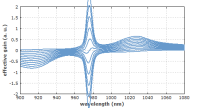Phototubes
Definition: gas-filled or vacuum tubes which can be used as photodetectors
More general term: photodetectors
German: Photozellen, Fotozellen
Categories: photonic devices, light detection and characterization, optoelectronics, optical metrology
How to cite the article; suggest additional literature
Author: Dr. Rüdiger Paschotta
A phototube (or photoelectric cell), invented by Julius Elster and Hans Geitel in 1893, is a photoemissive detector based on a small glass tube containing electrodes where the external photoelectric effect (or photoemissive effect) is utilized. Such tubes are often evacuated or sometimes filled with a gas under low pressure.
An ordinary phototube contains only two electrodes: the photosensitive cathode and an anode. During operation, some voltage (e.g. 15 V or 50 V) is applied to the electrodes (the positive pole to the anode), so that photoelectrons are rapidly swept from the cathode to the anode, and a photocurrent can be measured. For an evacuated phototube (vacuum phototube), the photocurrent depends on the incident optical power according to the equation
where η is the quantum efficiency, e is the electron charge, and hν the photon energy. (The quantity S is called responsivity.) The usable dynamic range can be quite large, for example with photocurrents between a few picoamperes (pA) and a few microamperes (μA), although the maximum allowed photocurrent is usually far below that of a photodiode. There is hardly any temperature influence on the responsivity.
Particularly for operation around the maximum allowed photocurrent, it is important to illuminate a large enough spot on the photocathode in order to avoid an excessive current density on part of the cathode.
The quantum efficiency essentially depends on the used photocathode, the used tube glass, the optical wavelength and the angle of incidence. Various cathode materials are available for use with visible light, infrared light or ultraviolet light, and glasses with high transmission in the relevant spectral range need to be chosen. (Note that not only absorption of light in the glass, but also the Fresnel reflection at the glass surfaces can reduce the quantum efficiency.) The achieved quantum efficiency is in most cases below 25%, in some cases even lower than 1%. Some devices are solar-blind, i.e., not sensitive to visible and near-UV light.
Operation at relatively long optical wavelengths (mid-IR spectral response) is possible when using a cathode material with low work function. In that case, however, that can be a significant dark current (i.e., photocurrent without incident light) generated by thermionic emission. In some cases, infrared phototubes are cooled (e.g. with liquid nitrogen) in order to reduce the dark current.
Tube Geometries
There are “head-on” tubes, where the incident light enters the device opposite to the electrical connector. Others are “side-on” tubes, where the incident light comes from the side, e.g. a 90° angle to the connector end.
Electronics for Phototubes
The electronics used in conjunction with phototubes can be similar to those for photodiodes, except that the required voltage is tentatively higher for phototubes.
A simple circuit with a load resistor for converting the photocurrent into a voltage may be used. An advantageous aspect is the typically lower electrical capacitance of phototubes, at least when comparing with photodiodes with large active areas. This allows one to use a higher load resistor for given detection bandwidth, so that a higher voltage is obtained.
A current amplifier, receiving the photocurrent as input and providing a voltage output, are also suitable for phototubes. Of course, low-bias operation amplifiers should be used to avoid an apparent dark current.
For operation in the picoampere region, care must be taken to avoid leakage currents e.g. on a circuit board or at the contacts of the phototube; one should not touch such things with bare fingers.
Gas-filled Phototubes
Some phototubes are filled with a gas, often a rare gas like neon (Ne) or argon (Ar) at a low pressure. If a high enough voltage is applied to the tube (e.g., 50 V or 100 V, depending on the model), one can employ an internal amplification mechanism based on ionization. Essentially, photoelectrons are accelerated enough to produce secondary carriers when colliding with gas atoms. Therefore, the responsivity can be increased e.g. by a factor of 5 or higher. The multiplication factor rises for increasing applied voltage; however, the operation voltage is limited by the onset of a glow discharge, which could damage the electrodes and leads to an essential undefined responsivity.
While the increased responsivity can be an advantage for sensitive detection of low light levels, the internal multiplication also introduces disadvantages. One of them is the dependence of the responsivity on the applied voltage, which may affect the accuracy of optical power measurements. Another aspect is that the achievable measurement bandwidth is reduced, because it takes longer to collect the carriers.
Photomultiplier Tubes
A special form of the phototube is the photomultiplier tube. This contains additional electrodes, with which a high amplification of the photocurrent can be achieved based on secondary electron emission. Such devices are normally called photomultipliers, i.e., a phototube is normally considered to be a simple tube with two electrodes only.
Photodiodes as Replacements
Nowadays, phototubes are largely replaced with solid-state devices like photodiodes, where the internal photoelectric effect is used. For some applications, however, phototubes can still have substantial advantages:
- They can have a lower dark current, leading to a lower noise equivalent power.
- They can be made with a large photosensitive area while still having a high detection bandwidth.
- The high dynamic range and high stability of phototubes can be advantageous for precise measurements, e.g. in spectrometers.
- Particularly for UV applications, the high stability (comparing with semiconductor devices, for example) can be a substantial advantage.
On the other hand, phototubes have a lower quantum efficiency, are more sensitive to mechanical vibrations and shocks, typically need a high operation voltage and can handle only a very limited amount of photocurrent. Particularly for high-sensitivity applications, it must be avoided that bright ambient light hits the photocathode while the device is turned on. In environments for helium can be contained in the air, it may happen that helium gas diffuses through the glass tube and then affects the performance of the phototube.
Suppliers
The RP Photonics Buyer's Guide contains 1 supplier for phototubes.
Questions and Comments from Users
Here you can submit questions and comments. As far as they get accepted by the author, they will appear above this paragraph together with the author’s answer. The author will decide on acceptance based on certain criteria. Essentially, the issue must be of sufficiently broad interest.
Please do not enter personal data here; we would otherwise delete it soon. (See also our privacy declaration.) If you wish to receive personal feedback or consultancy from the author, please contact him e.g. via e-mail.
By submitting the information, you give your consent to the potential publication of your inputs on our website according to our rules. (If you later retract your consent, we will delete those inputs.) As your inputs are first reviewed by the author, they may be published with some delay.
Bibliography
| [1] | J. Elster and H. Geitel, “Über die Entladung negativ electrischer Körper durch das Sonnen- und Tageslicht”, Ann. Physik 38, 497 (1889) |
| [2] | A. Einstein, “Über einen die Erzeugung und Verwandlung des Lichtes betreffenden heuristischen Gesichtspunkt”, Ann. Physik 17, 132 (1905), doi:10.1002/andp.19053220607 |
| [3] | H. P. Bonzel and Ch. Kleint, “On the history of photoemission”, Prog. Surf. Sci. 49 (2), 107 (1995), doi:10.1016/0079-6816(95)00035-W |
See also: photoemissive detectors, photocathodes, photodetectors, photomultipliers, photodiodes
and other articles in the categories photonic devices, light detection and characterization, optoelectronics, optical metrology
 |









If you like this page, please share the link with your friends and colleagues, e.g. via social media:
These sharing buttons are implemented in a privacy-friendly way!